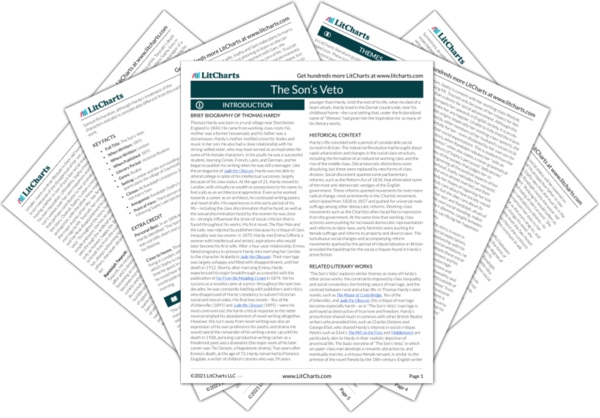Sophy’s braided hair symbolizes the useless monotony that characterizes her life as Mr. Twycott’s wife and widow. It is the first detail given about Sophy, and at first, it appears as a symbol of intriguing beauty. It hints at some of Sophy’s positive qualities, such as her self-sufficiency (“she had done it all herself”) and even a latent creative streak (her hair is described as “ingenious art”). However, her braided hair is also presented as a symbol of wasted effort (the fact that it is “demolished regularly” at night makes the effort seem a “reckless waste”) and even positions her as an object of pity (she is called a “poor thing,” her braided hair “the only accomplishment she could boast of”). The braided hair is a useless decoration, beautiful but also temporary, ultimately a waste of effort. This interpretation is supported when the narrator states that Sophy “wasted hours in braiding her beautiful hair” once she moves to the city, at the same time that the signs of her youthful beauty and vigor (like her apple-colored cheeks) faded. The braids are a futile, wasted ornament, a reflection of the role that married women were supposed to play within upper-class society—to ultimately serve as a pleasing aesthetic object for others’ enjoyment. This is a role that Sophy is never quite satisfied with, which is why her braids, a sign of her boredom and dissatisfaction, also mark her as an object of pity.
Sophy’s Braided Hair Quotes in The Son’s Veto
Throughout these changes Sophy had been treated like the child she was in nature though not in years. She was left with no control over anything that had been her husband’s beyond her modest personal income. In his anxiety lest her inexperience should be overreached he had safeguarded with trustees all he possibly could. The completion of the boy’s course at the public school, to be followed in due time by Oxford and ordination, had been all previsioned and arranged, and she really had nothing to occupy her in the world but to eat and drink, and make a business of indolence, and go on weaving and coiling the nut-brown hair, merely keeping a home open for the son whenever he came to her during vacations.










